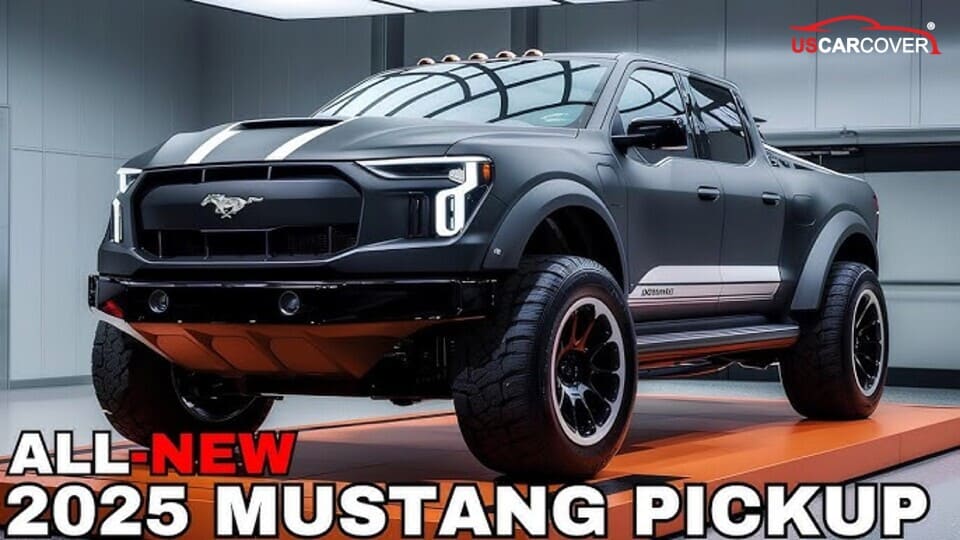
2026 Ford Mustang Pickup Truck is a topic that has generated a lot of buzz recently, and as a performance-truck reviewer, I want to provide a clear and accurate perspective. Many viral photos and videos online suggest that Ford is preparing to launch a Mustang-branded pickup. The truth is different. As of August 28, 2025, Ford has not announced any official Mustang pickup model. What you have seen so far are AI-generated renders and fan-made concepts, not real vehicles in Ford’s current or upcoming lineup.
From my professional point of view, it is important to separate fact from speculation. The Mustang nameplate today continues to represent the coupe, convertible, and the Mach-E SUV. A pickup truck wearing the Mustang badge simply does not exist at this time. However, Ford has officially confirmed something worth paying attention to. The company is preparing a new midsize electric pickup, priced at around $30,000, with production targeted for 2027. While this EV is not part of the Mustang family, it shows Ford’s commitment to bringing more performance-oriented trucks to the market.
My verdict is simple. There is no official 2026 Ford Mustang Pickup Truck available today. Still, Ford’s confirmed plan for an affordable EV pickup may influence the future of performance trucks and create a foundation for what a Mustang-inspired pickup would need to achieve if Ford ever chooses to build one.
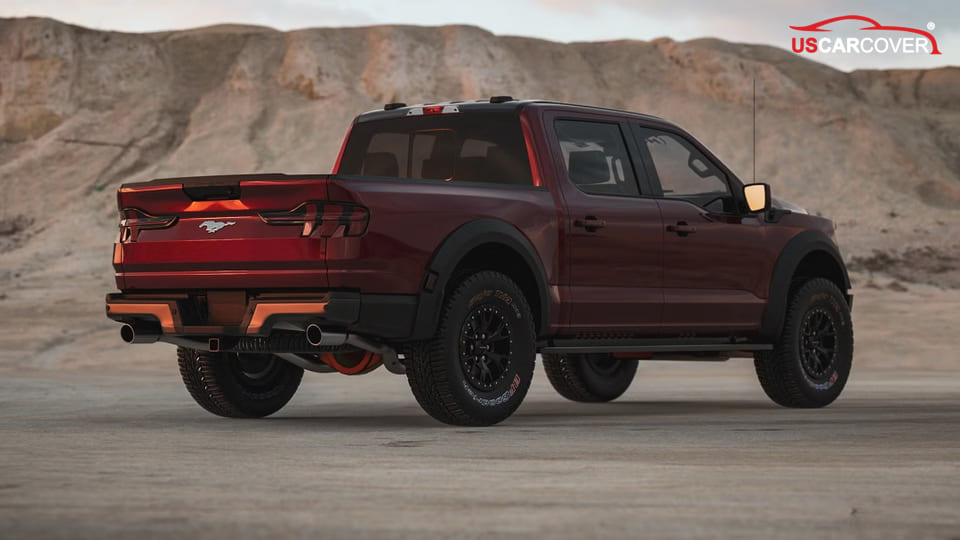
What Ford has officially announced
As verified, Ford has publicly confirmed a major program to deliver an affordable midsize battery electric pickup. The company is investing roughly $5 billion in a new production system and Universal EV platform, and the first product from that effort will be a four-door midsize electric truck aimed to start sales in 2027 with an entry price target near $30,000. Assembly work for the program will be centered in Louisville, Kentucky, and the investment is expected to create thousands of U.S. jobs.
Why this matters for performance-truck buyers. An inexpensive, lightweight EV pickup architecture changes the equation for sporty variants. A purpose-built EV platform makes it easier to offer high-torque powertrains, lower center of gravity, refined chassis tuning, and over-the-air performance calibrations without the packaging compromises of a conventional body-on-frame truck. Ford has explicitly called out modular assembly methods, cost-effective LFP battery choices, and features such as hands-free driving and OTA updates as part of the program, all of which create a plausible path to affordable, performance-oriented trims even if the model is not Mustang-branded

Related Articles: 2026 Toyota Land Cruiser Mini Review: A Veteran Car Reviewer’s First Impressions and Insights
If Ford built a Mustang Pickup: my engineering blueprint
Note: the following is clearly labeled expert speculation based on Ford’s announced platform direction and common automotive engineering trade-offs. This is not a claim that a Mustang pickup exists.
Platform choices
If Ford wanted a true Mustang-flavored pickup, they would face a platform decision with direct handling versus utility consequences. A unibody approach, like the Maverick or crossover platforms, delivers lower mass, tighter chassis stiffness, and better on-road handling, which supports the sporty character Mustang buyers expect. A body-on-frame architecture, like Ranger or F-150 heritage, gives superior payload and towing robustness but weighs more and compromises cornering precision. Choosing unibody would favor driver engagement, while body-on-frame would favor utility.
Powertrains I would expect
Realistically, a performance Mustang pickup would most likely use one of two routes. Option one is a performance-tuned hybrid that blends electric torque fill with a gasoline engine for range and heat management. Option two is a battery electric vehicle that leverages instant torque and flexible packaging to keep the bed and cabin usable. A V8 option is possible for halo low-volume variants, but it would face regulatory and weight penalties that make it less likely as a mainstream choice given the industry shift toward electrification. Ford’s public push for lower-cost EV architectures makes hybrid or BEV the more probable performance path.
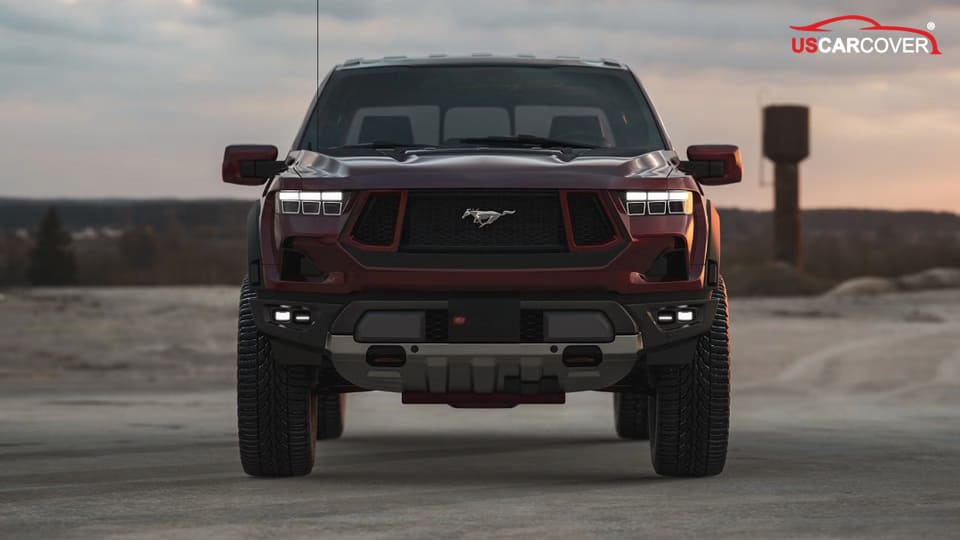
Performance targets that make sense
If Ford wanted a Mustang badge to be credible on a pickup, sensible engineering targets would include:
- A flagship 0–60 mph time in the sub-5 second range for the top trim, achievable with a focused EV or a high-output hybrid.
- Towing and payload tuned below full-size work trucks but above sport crossovers, so the truck remains usable without compromising handling.
- Adaptive, high-performance damping similar to MagneRide class systems for fast compliance and chassis control, aggressive braking hardware, and sticky 20 to 21 inch tires for grip and repeatable track performance. MagneRide and similar magnetorheological systems are already used on current Mustang performance models, so carrying that technology into a performance truck would be a logical move.
Design and aerodynamics: translating Mustang DNA to a truck
Signature cues
The easiest, cleanest way to signal Mustang heritage on a truck is to borrow Mustang styling shorthand: tri-bar LED headlamps and taillamps, a long hood with relatively short overhangs, sculpted fender arches, and a fastback-inspired roofline or cab silhouette that reads sporty even from a distance. These elements are core Mustang identifiers on current models.
Aero priorities for a performance pickup
When you mix sport-car DNA with a pickup bed you must pay extra attention to airflow. Practical aero devices that work on modern Fords include active grille shutters and deployable lower air dams to cut drag at speed, a smooth underbody to reduce turbulence under the truck, and tailgate or tonneau treatments that reduce the wake behind the bed. The design goal is to keep a sleek profile for high-speed stability while retaining useful bed volume and access. Ford has already used active grille shutters and tailored tailgate geometry in its trucks to improve efficiency and reduce drag, so those are logical tools for a Mustang-flavored pickup as well.
Design trade detail to watch for
Keep the roofline and C-pillar shaping subtle. Overly aggressive fastback shaping can make the bed shallow or unusable. A successful solution blends Mustang cues into the cab and fender language while using aero tricks and add-on spoilers or tailgate spoilers to control wake without sacrificing practicality. Motor and aero packaging, not style alone, will determine real-world usability.
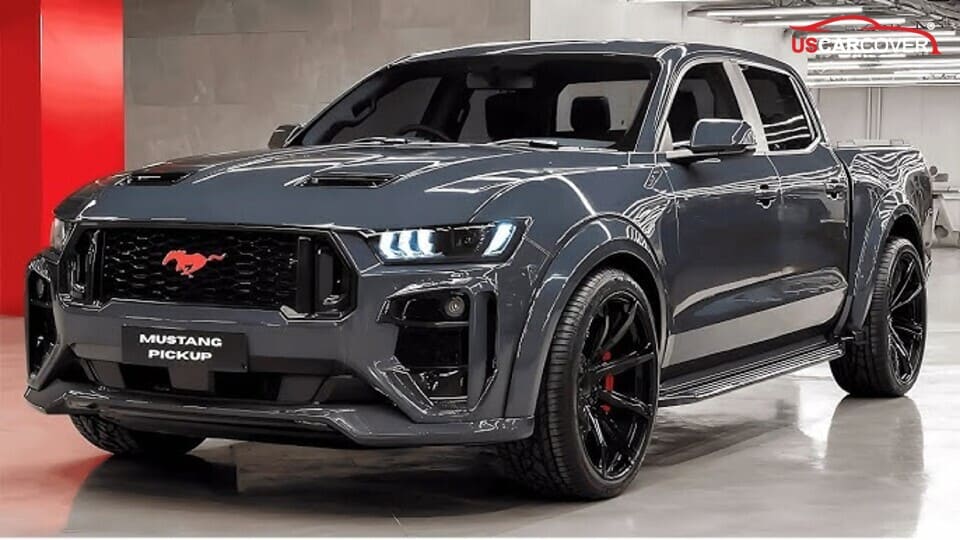
Chassis, payload, and towing trade-offs
Platform and suspension choices
There is a fundamental choice between unibody construction, which favors lower mass, tighter chassis stiffness and better on-road handling, and body-on-frame architecture, which favors payload durability and heavy towing. Compact and crossover-like trucks have moved to unibody layouts to deliver carlike handling, while traditional midsize and full-size work trucks remain body-on-frame for robustness. If the goal is credible Mustang driving dynamics, a unibody or specially stiffened EV skateboard will be the easier route to sharp handling. If Ford wanted substantial towing and payload, body-on-frame is the safer choice.
Suspension tuning and ride intent
For a performance pickup the suspension should bias handling and control over maximum payload. Independent rear suspension on a unibody or EV platform preserves wheel control, reduces unsprung mass and helps cornering, while live axles or solid rear axles give ultimate strength for towing and extreme payload. A Mustang-branded truck intended to feel like a sports car would likely keep an independent rear layout or a sophisticated multi-link rear to protect handling. Examples across the segment already show this split: compact unibody pickups ride and turn more like cars, midsize/body-on-frame trucks emphasize towing.
Brake and spring strategy
A performance pickup must prioritize fade resistance, brake and cooling capacity, strong anti-roll control, and spring rates that balance cornering with usable load. In short, the tuning should favor consistent track-capable braking and body control rather than towing-maximizing spring rates. That means larger ventilated rotors, multi-piston calipers where needed, and adaptive damping for ride control and composure under high lateral loads. Ford already offers MagneRide-class adaptive damping and high-performance brake packages on Mustang models, and those technologies are the right reference points for a performance truck.
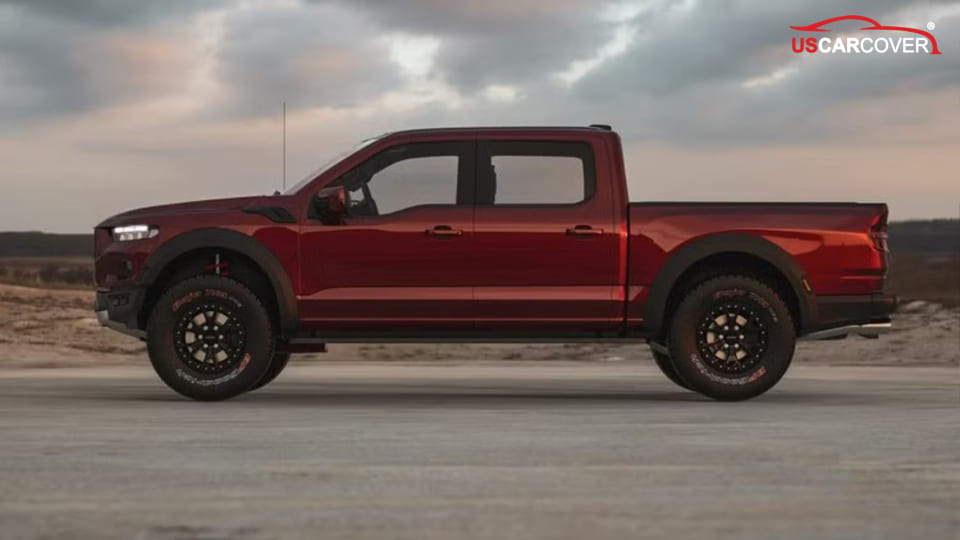
Cabin and tech: performance-first ergonomics
Driver-focused seating and controls
A Mustang pickup cabin should read like a cockpit. Expect deep-bolstered sport seats, a relatively small diameter steering wheel for quick inputs, clear analogue/digital readouts of speed and torque, and physical toggles or a dedicated drive-mode switch cluster for instant access to performance modes. Those tactile controls matter more on track days than a purely touchscreen-driven layout.
Infotainment, telemetry and ADAS
Ford already ships Track Apps and FordPass Performance features that log acceleration, lap, and braking metrics, and it pairs those with SYNC infotainment for data display and sharing. Combining that telemetry with over-the-air software updates and hands-free highway assistance would be a natural fit. Ford’s BlueCruise is an available hands-free highway driving system, SYNC 4 provides the modern infotainment backbone, and Ford has committed to over-the-air update capability across many models, so a Mustang truck could reasonably include track telemetry, OTA performance calibrations, and BlueCruise-style driver assistance as part of its tech suite. Exact features would depend on program decisions, but the platform and existing Ford systems already support that direction.
Track-day extras to expect
Think data logging, in-cabin lap timers, selectable stability and traction maps, drive-mode presets saved to keys or profiles, and an optional “track coaching” mode inside the app for driver feedback. Ford has offered similar functionality in Mustang Track Apps and Ford Performance apps, so translating those experiences into a pickup is feasible if the program chooses to prioritize it.
Pricing & trims (scenario analysis, not claims)

Pricing & trims
This is scenario analysis, not an assertion that Ford will build these trims. Use these ranges as a market-based projection that balances Mustang heritage with pickup economics.
Entry GT-line (unibody / hybrid scenario): target starting price in the low-to-mid $40,000s.
Rationale: slotting above the compact Maverick and below existing Ranger Raptor pricing makes sense for a performance-oriented but relatively mainstream trim. For context, the Maverick starts around $28,145 on Ford’s site, while Ranger Raptor sits well above typical midsize base trucks.
Track-pack or “Dark Horse-style” EV or hybrid (flagship): high-$50,000s to low-$60,000s
Rationale: a halo trim with larger battery or hybrid hardware, upgraded brakes, sticky tires, and track-ready suspension would push pricing into Raptor-adjacent territory, but an EV-based architecture can keep costs lower than a full-size halo Raptor. Use current Raptor pricing as a market reference when imagining a flagship Mustang pickup.
Carbon and handling option packages: priced separately as add-ons.
Typical contents would be forged wheels, multi-piston brakes, carbon-fiber trim or aerodynamic add-ons, and a performance suspension pack. These packages usually raise effective price incrementally rather than changing base MSRP dramatically.
Key caveat: these are market-positioning scenarios informed by current Ford products and segment pricing. Actual trim strategy and MSRPs would depend on platform choice (unibody versus body-on-frame), powertrain, and Ford’s product planning.

FAQs
Q: Is the 2026 Ford Mustang Pickup Truck real?
A: No. There is no official Ford announcement that a Mustang-branded pickup will be sold as a 2026 production model. Many viral images and video "reveals" are AI-generated renders or fan concepts, not factual product announcements. Reputable outlets have flagged those renders as not real.
Q: Did Ford announce a new pickup at all?
A: Yes. Ford has announced a program to build a new midsize electric pickup on a universal EV platform, with a targeted starting price of about $30,000 and production aimed at 2027 in Louisville, Kentucky. That confirmed program is not Mustang-branded, but it is important because it creates a production pathway for affordable, performance-capable trucks in the future.
Q: So when is the Mustang pickup release date?
A: There is no release date because Ford has not green-lit or announced a Mustang pickup. If Ford decides to develop a Mustang-branded truck, expect the standard product timeline of concept/prototype disclosures, regulatory filings, and factory tooling announcements before a concrete release date appears.
Q: What engine will the Mustang pickup use?
A: No confirmed engine exists because no confirmed vehicle exists. Based on industry trends and Ford’s public EV strategy, a performance-oriented hybrid or a battery electric powertrain is more plausible than a mass-market new V8, particularly for mainstream trims. A V8 halo variant could still appear as a low-volume model but would face emissions, cost, and weight challenges.
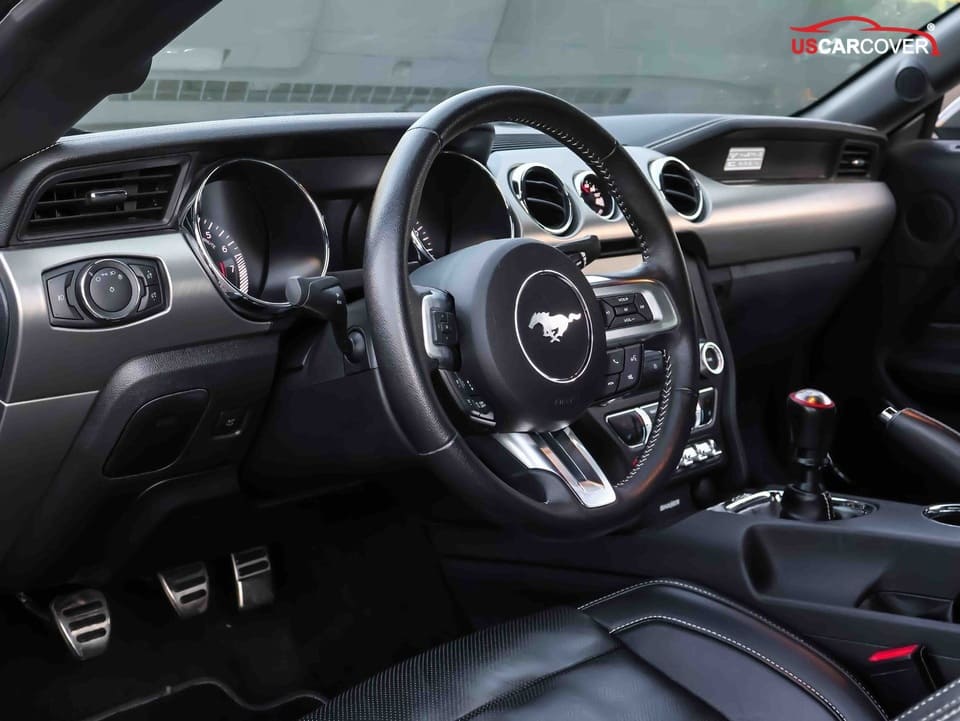
Conclusion
There is no official 2026 Ford Mustang Pickup Truck as of August 28, 2025. What matters right now is Ford’s confirmed plan for an affordable midsize electric pickup targeted for 2027. That program is important because a purpose-built EV pickup architecture makes credible, performance-oriented truck variants technically and commercially possible in the near future—even if a Mustang-badged pickup is not currently planned.
If Ford ever decides to put a Mustang name on a pickup, it will need to balance two opposing priorities: sports-car handling and real-world utility. The most plausible engineering path is a unibody or EV skateboard platform for low center of gravity and sharp handling, paired with performance-tuned hybrid or full EV powertrains for instant torque and repeatable performance. Expect flagship performance targets to emphasize sub-5 second 0–60 sprints, adaptive damping, upgraded brakes, and high-grip tires, while pragmatic trims would trade some of that for towing and daily usability.
For buyers today, pick the product that matches your priorities. Choose the Ford Maverick for an efficient, sporty compact daily. Choose the Ranger Raptor for midsize off-road performance. Choose the F-150 Raptor (or Raptor R where available) for maximum desert and extreme off-road capability.
Finally, if you drive an earlier-generation Mustang or any Ford pickup, protect that investment. A high-quality car cover will preserve paint, trim, and finish from sun, dust, and weather. Check out USCarCover.com for durable, weather-resistant covers that fit indoor or outdoor use and offer affordable protection for Mustangs and Ford trucks. Protect your ride now so it stays ready for whatever the future of performance pickups brings.
